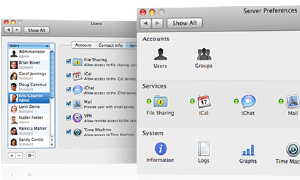Apple's new frontier: servers for the rest of us?


What my server admin buddies all tell me is that the real power of Mac OS X is under the hood. The best way to access its Unix services, they insist, is through the command line. For these guys (and gals), the lipstick of the Mac's refined GUI just isn't good enough.
And they mock my appreciation of and reliance on the evolved Mac interface and my wish to avoid the Terminal app. I mean, we're talking about a client machine here.
Now, Apple is looking at a new challenge: small business servers. According to Apple, Leopard Server includes more than 250 new features, including a new content server for wikis and podcasts, and a CalDAV-standard calendar server.
One interesting part of Leopard Server is its positioning. Apple is looking at making inroads into new market segments in very small businesses and into existing SMB sites. This is actually new — go figure.
In the past, Apple says its OS X Server was targeted to an IT audience. While it offers a range of management tools, these tools were "easy" versions when measured against the skill set of the intended audience. The server package and Xserve, Apple's server hardware platform have been aimed at IT organizations with existing infrastructure.
Now, IT professionals have been suspicious of the Mac over the years and even hostile at times to the Apple brand. In addition, enterprise and businesses have long-standing ties to PC technologies and PC brands.
According to Eric Zelenka, Apple senior product line manager for servers, Leopard Server's positioning will still hold to that IT path, but will target specifically small businesses and workgroups within large organizations. He told me that these market segments have traditionally been hesitant to install servers because of worries around correct setup and day-to-day management.
"The primary goal of Leopard server to radically change users' perception of servers. We will make them very easy to set up, very easy to manage and very easy to monitor," he said. [Leopard ] has changed the complete out-of-the-box setup experience to make it easy to set up on the network, whether it's a stand-alone server, or a server that needs to integrate with the company's network, or even if you're an IT administrator. We've simplified that process."
When customers open Leopard Server, the second screen they see will be a new selection matrix. Users will declare whether they want a Standard, Workgroup or Advanced setup. The Server Assistant will then do the work of setting up the server.
Standard. This will be a "simple deployment" of Leopard Server for a business that has never used a server before.
Workgroup. This setup is designed for customers integrating Leopard Server into a company's existing environment. It won't start up services that aren't needed and will leverage established settings for accounts and use the existing authentication, such as Active Directory.
"If you have the infrastructure, we won't let you set up a VPN. We ask you where is the LDAP server, mail server to relay mail. It's all done to fit [Leopard Server] into the existing environment," Zelenka said.
Advanced. The kitchen sink.
The management tools for each set of customers is different too. Apple is taking the UI concepts from the client side and bringing them over to server applications. So, for example, when Leopard Server Assistant goes to work, it checks the condition and performance of the network automatically, much like the hardware and software health check your Mac does when it starts up.
A new Server Preferences application brings over the look-and-feel of System Preferences on the Mac. This gives novice users access to services for file sharing permissions, VPN, accounts, security, mail, calendaring and the content services. For backup, Leopard Server will use Time Machine. This will be the primary interface for Standard and Workgroup setups.
Zelenka said that for managers of Advanced setups, Leopard Server will feature upgraded versions of its current Server Admin and Workgroup Manager tools. Command line admin is also improved, he said.
The Server Assistant software will deliver "sets of admin apps that can scale depending on who's deploying it. If you're an IT admin and do fine detailed spam prevention or filtering all the content that's coming into your organization, we give you the tools for that control. But for many people in a small business with only 20 people in their organization, we provide a much simpler interface for controlling those settings," Zelenka said.
The words "simple" and "Unix server" are usually not found in the same sentence. But Apple has worked this same magic for the Macintosh with OS X. We used to call something that looks and functions like the Mac a Unix workstation.
The Macintosh was designed to be the "computer for the rest of us." Perhaps Leopard Server is start of the server for the rest of us.